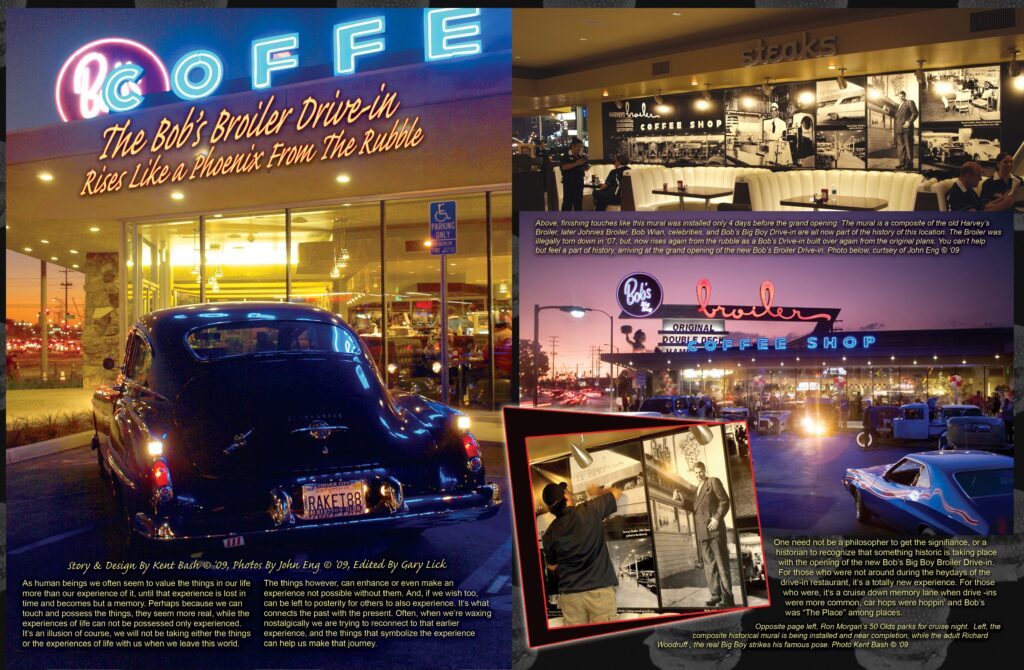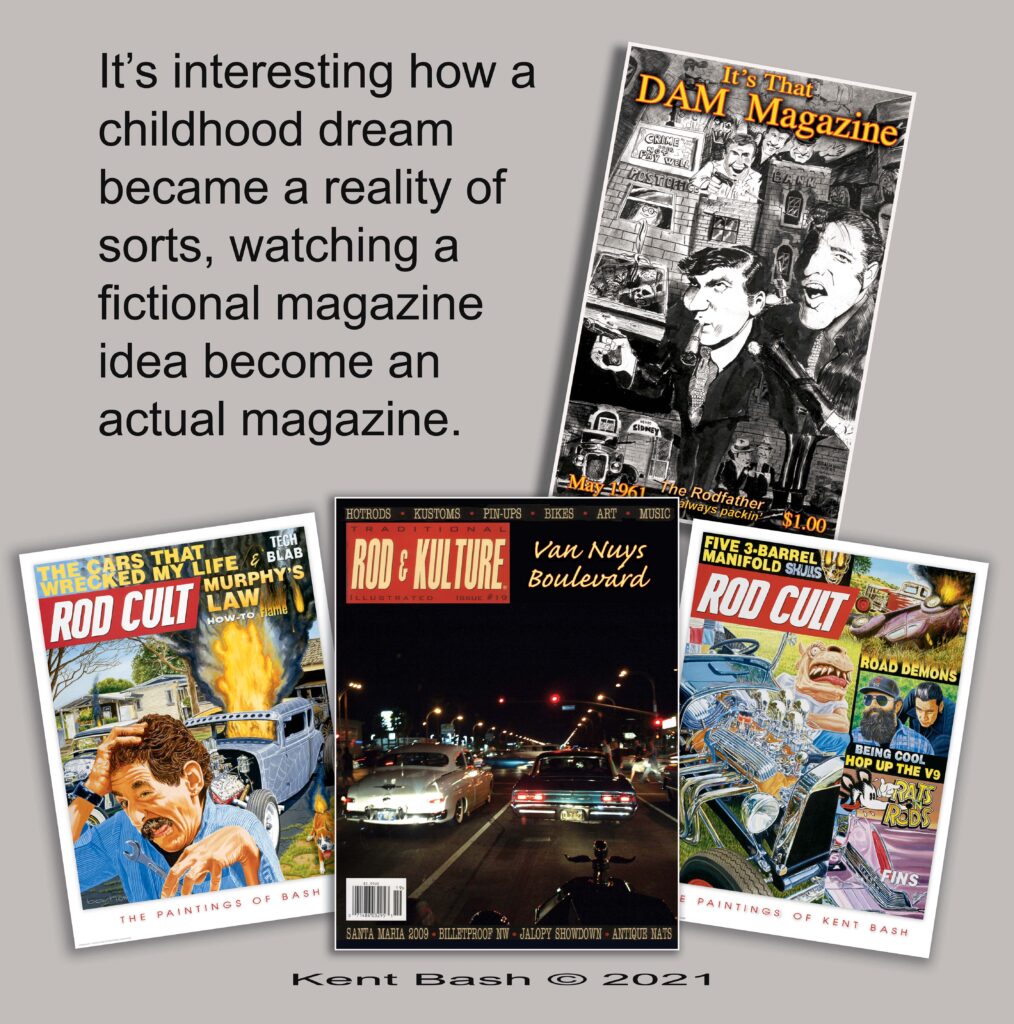Like many young impressionable boys in the fifties, my imagination raced with the images of America’s emerging pop culture. Comics, science fiction magazines and pulp paperbacks were all required reading. Building models, listening to rock-n-roll music and dreaming of hot rods were all part of the mix of adolescence. Back then, you just weren’t hip unless you had a rod. So, I watched with envy as my brothers built their first hot rods. I got to share in many of their first adventures, discovering the joys of leaf springs, dirt roads and learning about geography from a rumble seat. Jack Kerouac and the beat generation, Henry Felsen’s hot rod books and the little bit of Rock-A-Billy we could tune in on the country music station in the rural west San Fernando Valley was all part of the backdrop of my youth. That old Model A was part hot rod and part roll-a-coaster. I used to think any moment it would come apart in a million pieces. Still, nothing seemed cooler than for the three of us to disappear in a cloud of dust. It’s an image that is tattooed in my memory
There was little if any in the way of radio or TV reception, so if you were looking to be entertained other than exploring the area, one had to look inward and become the source of the entertainment.
Creating an interest was a necessity, if one wanted to do something besides count the occasional horse, donkey, or car kick up dust on its way by. Instead, I built models, read books, comics, and began to draw.
Daydreaming about space travel, visiting other worlds, history, and cultures seemed a sure fired way to get the imagination busy, and break up the monotony of living comatosed on a dirt road in fall asleep no place.
The thing about developing an interest is that it is mobile, it goes where you go, it’s invisible, no need to box it up, pack it away, it’s light weight, hard to steal, and it’s all yours.
Before I was able to enter junior high, my brothers moved out on their own, and my parents split. To keep my mother from getting custody, my father took off with my sister and I, and we moved from place to place. I attended 37 different junior high schools, before I began high school. And in near each, I was the new kid from LA, so I was a tuff guy, so I always had to fight. I was no tough guy, and I didn’t like to fight. It got tiresome, and it was making me very angry. Angry at my father, angry at the situation, angry at being bullied, and pushed around, and angry with all do-gooder adult authority figures.
We never stayed in one place long enough to make friends, so I channeled my energy, and anger into my drawing. I had an 11” X 14” leather portfolio that I kept drawings, paper, and something to read in. These, charcoal and ink drawings were done at age 11 and 12. The Chevy sedan was painted with poster paint at school.
I didn’t know anything about art, and I certainly didn’t know the materials, or how to use them, everything was trial and error, learn by doing. It seemed the only peace I had was to work in solitude, and keep my interest to myself. I didn’t care to share it. What people didn’t know about, they couldn’t destroy. I didn’t see myself in a competition with anyone, or that I was better. I was learning I could be effective, and that I was improving the more I did. It was great to see an idea come to life, because of your hand, and mind. I was just a kid, and didn’t see this as developmental stage mentally in becoming an artist. But, retrospectively, they were the beginning steps of critical thinking.
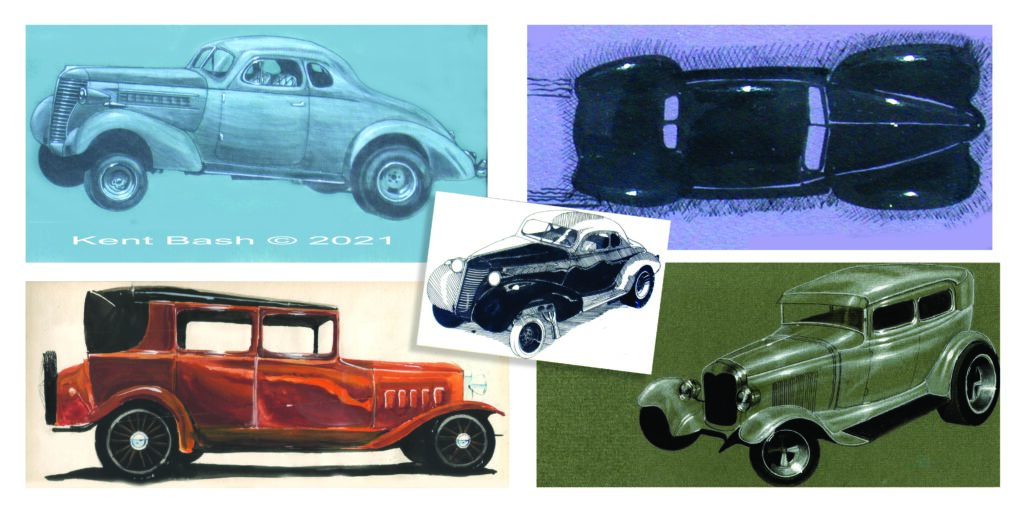
To push it all into a funnel,, and compress it into something simple. My Mother & Father fought each other the rest of their lives using my sister and I as the tools as long as they could, which for me ran out in high school. The police finally caught up with my father, and now it was my mother’s turn to fan the flames of hate. It just made me to despise them both. After my mother’s new husband put his hands on me I snapped, and hit him as hard as I possibly could, sending him to the hospital. The following day at school, it was the two bullies that had been dogging
me, and now it was their turn. As they walked behind me, one kicked the books from my hands. I did nothing at first, as I gathers my books and papers as they laughed, but my anger from the night before was still boiling Bully # 1 had his next call near mine, after putting my books in my locker I walked over there, and up behind him, as his friends began to laugh, he turned around I hit him as hard as I could in the jaw, and he went down like a sack of potatoes, as all his friends took off, as did I. Bully number # 2, had a class near my wood shop class. He was
always late, as was my wood shop teacher, so when he was about even the open door, I stepped out and hit him with a 2” X 4” right in the chest. When he fell down I proceeded to kick him, pouncing on him, beating him in the face, and yelling, “I’m not the toughest, just the craziest”. By this time, my wood shop teacher showed up, and said he was going to give me a swat. And, I said. “Pushing me around ends today, this is the beginning of the end of that”. He then backed off.
This was my world, it seemed like enemies in all directions, except one, my love of art. This was a monumental experience, and I had cracked up. I felt like two different people, because I was. My art was my escape, my safe haven, the place where I was at one, and at peace with myself. I had to change my other world. I had been working as a box boy at the market a couple of years. I was too young, so I lied about my age. I decided to move out on my own again, to escape my mother’s manipulation, control, and hate.
This was a very profound and important step, though legally still under age. I worked only part time so I could continue with my education. I was only in the 10th grade. I earned enough to pay my rent, but not enough for food. So I painted signs for our market, and for a near by music store. It was tremendously hard with both work, school, and extra side jobs, but for the first time in memory, I was happy, and lived in my new world without hate, violence, and anger. I felt happy. I was very proud that I was able to change my world for the better.
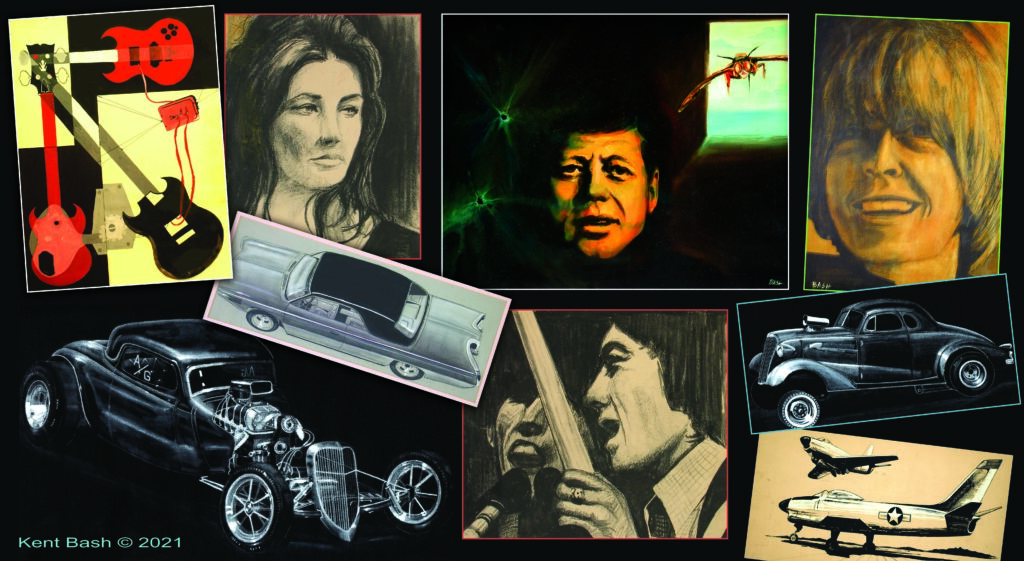
As a consequence, there was an explosion in my art, and I painting my first works of expression, such as my oil painting of JFK, entitled, “Sneak Attack”, shortly after his assassination, an abstract of a Gibson Bass I wanted, cartoons, people, and of course more cars. I always remember what my 5th grade teacher Mrs. Rummel said to me, because I didn’t like reading in front of the class, I told her I liked to read in my special place, by myself. She placed her fingertips on my temples, and said, “Kent, you’ll always have that special place, right here”. Without her kind words I would have been truly lost. She spoke to us like people, with respect, not like children.
My conflict with adult authority figures was not yet over, but being pushed was. An art teacher in high school had contempt for me, I guess because I could draw, and she couldn’t. I had a drawing I was working on clipped to my notebook. In dead time at school I would work on it some. This set her off, seeing me enjoy my passion for the very thing she was trying to teach. Her jealously apparently had been building and she snapped when I came to class with yet another drawing I’d been working on clipped to my notebook. She said, “Kent, will you please turn your notebook over. I don’t want to look at your drawing. ”I laughed, I couldn’t help myself. She said, “What’s so funny mister?” And I said, “ That we should be looking at or doing any art in your class.” All the kids burst into laughter. It was the truth. We all hated her crappy class. She couldn’t draw a straight line with 3 rulers, and had no business being an art teacher. She didn’t know anything to teach.
She sent me to the principal’s office, like she did every few days.
The principal wasn’t happy with me coming to his office every other day, but he seemed to understand. However, after getting booted from her class a few more times, the principal decided on my punishment. My assignment for being a wise guy, for being disrespectful, and booted from her class was to create and organize the first school art show. It would be on view during the lunch hour. He said it was a constructive punishment for having aggravated my art teacher all semester. He had me report to him every Tuesday before lunch with a progress report. The semester ended and I was finally out of her pain-in-the-ass art class. However, the principal didn’t forget, or let me off the hook. My other art teacher said he would help since I didn’t know all the good artists in school, and I had no experience with organizing an art show.
Because my new art teacher coordinated the show, I focused more on my display, which consisted of mostly fictional magazine cover drawings. All the work had been done at home. Since I had to report to the principal weekly, I showed him what I wanted to display, and then explained it, which he did seemed to appreciate. I got his okay on the work because most of them contained graffiti in the background on the walls and alley ways. The graffiti was somewhat off color, or in bad taste, but far to small to even read. It seems my former art teacher took it upon herself to do some policing of the art show she had no say in, and decided that she needed to censor by destroying my work by painting over everything she found offensive destroying all 30 pieces, except the very last one which I caught her painting on when I walked in. I grabbed the paint from her hand and threw it all over her, just as the principal walked in behind me. I screamed at her for destroying all my work, “If you didn’t like it why didn’t you just take it down you idiot.” Sensing I wanted to strangle her, my principal picked up where I left off, brow beating her for harassing me all year, for defacing my art, art he had already viewed and approved of, and for sticking her big fat nose in where it didn’t belong.
My anger fostered a bigger idea. Create something they couldn’t censor, something that was offensive because it was out of the ordinary, but not illegal. The idea kinda gelled in Mr. Craven’s drafting class. I couldn’t help but put the idea down even though there was a class project I was supposed to be working on. He caught me of course, and snatched up the drawing. Later, after writing his note on it, he returned it and said, “I think your idea is more important than what we are learning in class today. “I thought you were all hot rodder to the core, but this seems like more than that. I heard about all that art being destroyed. A real shame.” Mr. Cravens was a hard teacher, but he was also cool, he got it.
The idea had nothing to do with hot rods. I wanted to make a painting you could drive. I imagined most people would find it disturbing almost sacrilegious. And, that’s kinda what I wanted, a collision of the senses. Today art cars are nothing new, but back then this was a shock. People would gather around it, and debate and argue about what it meant, and how could somebody be allowed to do this. Which was the reaction of the police, and why I received 80 tickets in the first year. They couldn’t find a law to write me up for, so it was near always a mechanical violation, like my tail lights were not bright enough. Out of all the tickets, there was only one actual violation for not coming to a complete stop, before turning the corner.
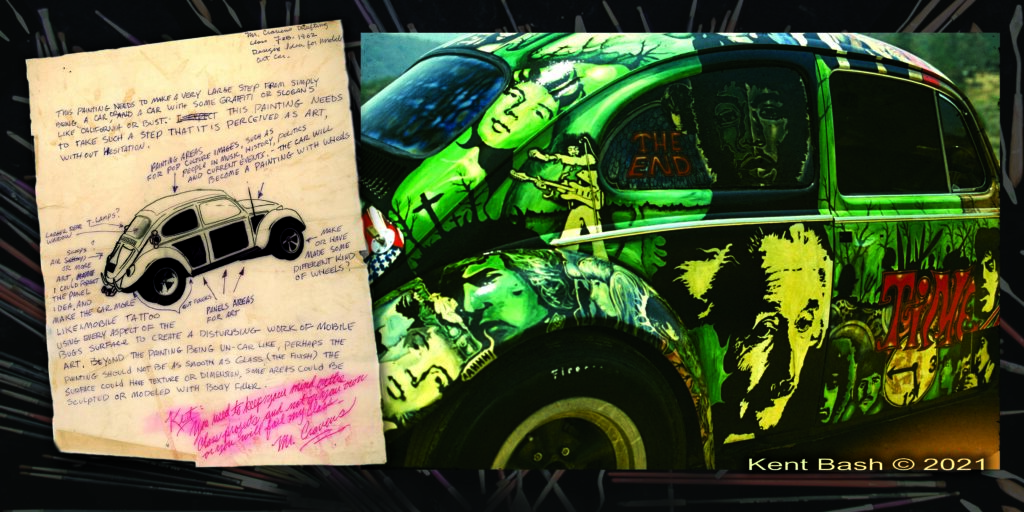
I wanted a painting with wheels, something that wasn’t confined to a classroom, an art show, or a gallery. I thought the VW Bug would be the perfect platform for this idea. They were cheap, ugly, and more often than not I could pick up one for free because VW Bug bodies were being discarded, and replaced with Fiberglass Dune Buggie Bodies, the rage of the moment. But, that wouldn’t last, and I knew it. The easy free access made what I wanted to do easier because there was little or no money invested. I thought it would be the perfect platform for a rolling work of graffiti, more art than car. I kept it hidden and covered because I didn’t want any comments, or anyone trying to kill my dream, interfere or to try and stop me.
My painting skills were lousy, I didn’t know what to use, or what would work so I tried everything to find out. I also had to break it down in my mind and remember I couldn’t paint it all in couple of days, weeks, or even months. I worked on one area at a time so that the whole project didn’t seem so overwhelming. This idea worked and helped me stick with it, and go the distance. I would create 7 in all beginning in 1962 with my first. And it all began with my arrogant art teacher destroying my work. It may have seemed ridiculous, yet, it was the spark. The real significance here was channeling my anger into something creative, instead of violence reaction. It was as though my interest, and passion with art was helping me grow, and change for the better.
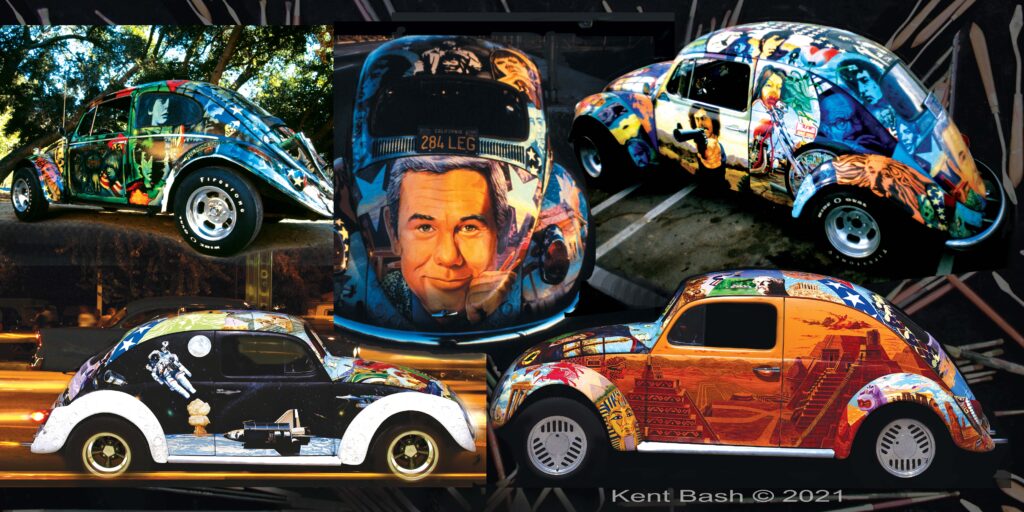
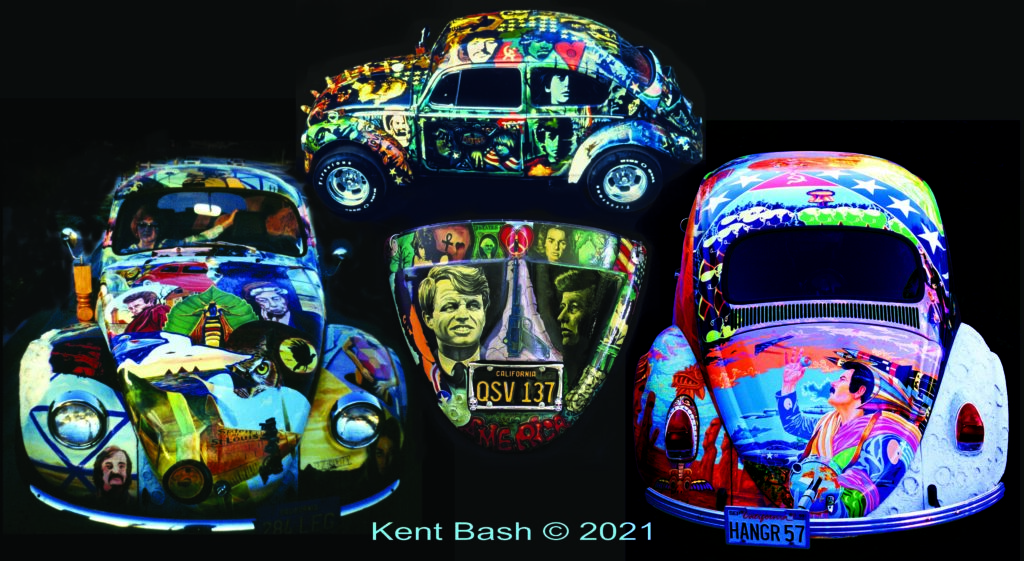
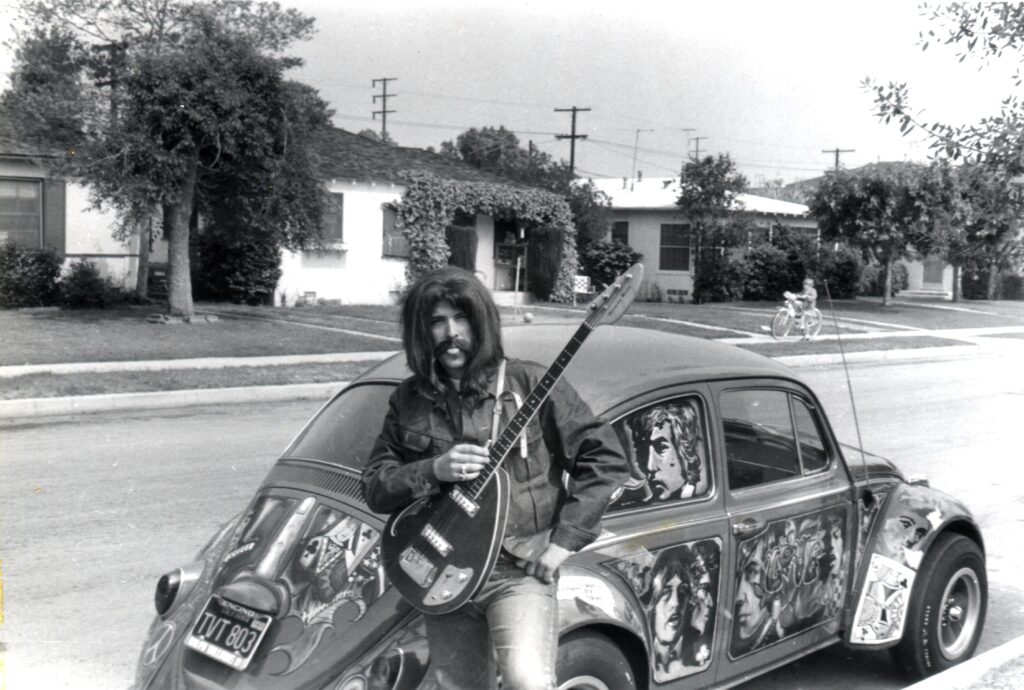
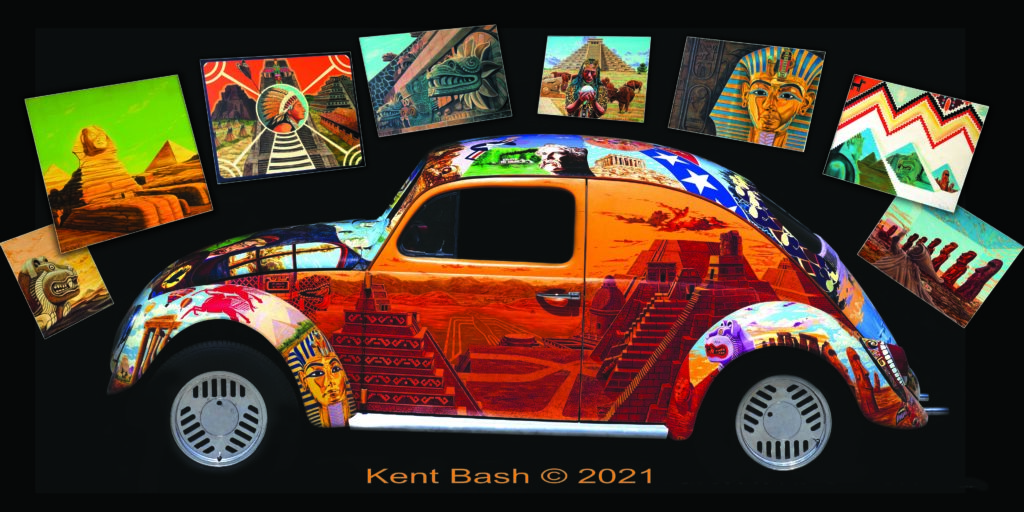
Painting using more traditional materials was not forgotten, as there was a steady flow of them. At times they seemed to parallel the Mobile Paintings as in this example. Sadly, this last example was destroyed by a collector who disregarded how to take care of it. This was the last surviving complete example.
My first ultra large studio, and living space was a raggedy looking barn that had been converted into a huge shop, theatre, dark room, office space, and a secret hidden speak easy, which I found by accident one night when I leaned against the bathroom wall, and magically the wall open into a hidden bar. Likely converted during prohibition, by the then owner Harry Jansen, a famous magician. His shop was where he built his magic acts, some of which still lay waiting for his return to finish them. His ranch lay abandon for a great many years while the property was in a long protracted legal quagmire. A friend had stumbled across it, looked up the attorneys handling it, and he was able to acquire it as a live on the grounds caretaker, as the property had squatters. They hadn’t broken into any of the buildings yet, but it was just a matter of time. My friend called me after he had moved in, and asked, how would I like to have a huge studio and living space for free. The tattered looking barn was cover for what was inside.
Having enough space was always a problem. For me this was a matter of good timing, so I moved right in. Harry Jansen, known as Dante was considered the last, and perhaps the best of the legendary magicians. The property was quite large, and contained a number of out buildings, a large house, pool, tennis court, a bamboo bar, next to the pool, and a number of changing rooms made from cedar. His ranch was a sleeper without a doubt. This was also during the time of the fiberglass dune buggy craze. VW Bug owners were discarding complete VW bodies in fields around the San Fernando Valley. So I collected a few for my mobile canvas fleet, and worked on several at this location. Not exclusively though, painting on more traditional surfaces also flourished. I had two major tools, plenty of time, and plenty of space.
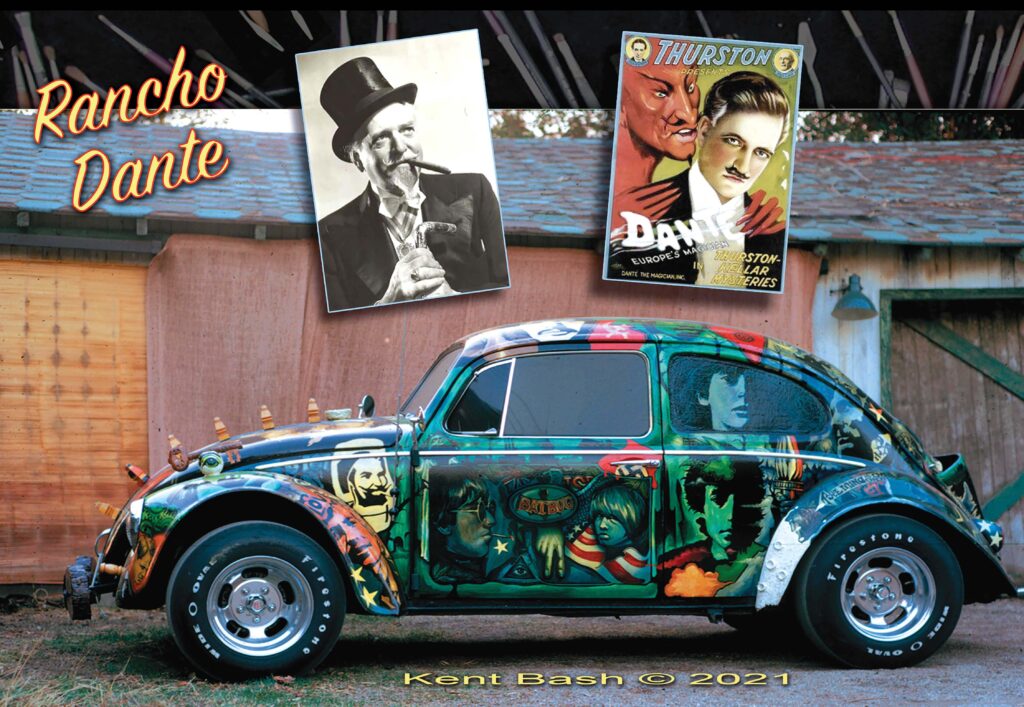
This was the barn, it gave you no clue what was beyond the door. It was a truly amazing situations, and my world of art exploded in so many directions. I can only say, I wished it had lasted much longer.
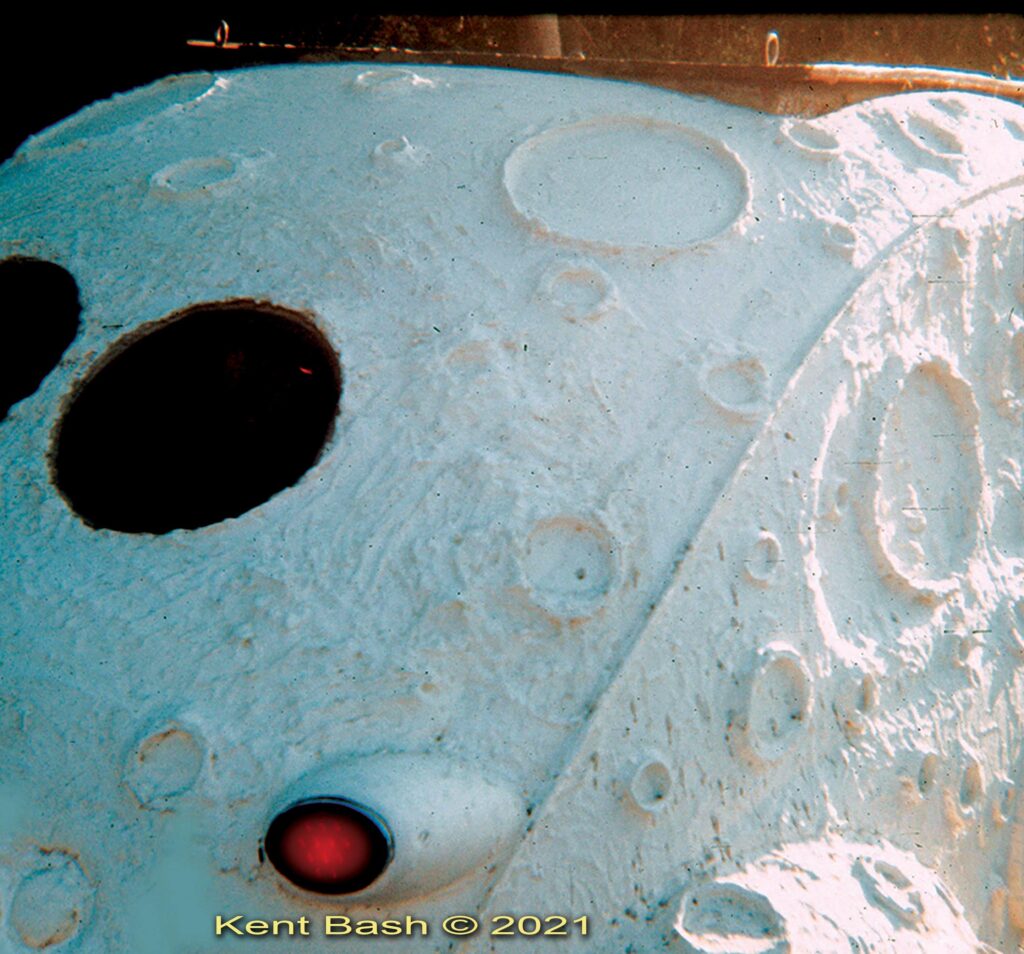
Sadly this is the only surviving photo of the Moon Bug that I have. The rear windows were also moon craters. I had so much fun with this one.
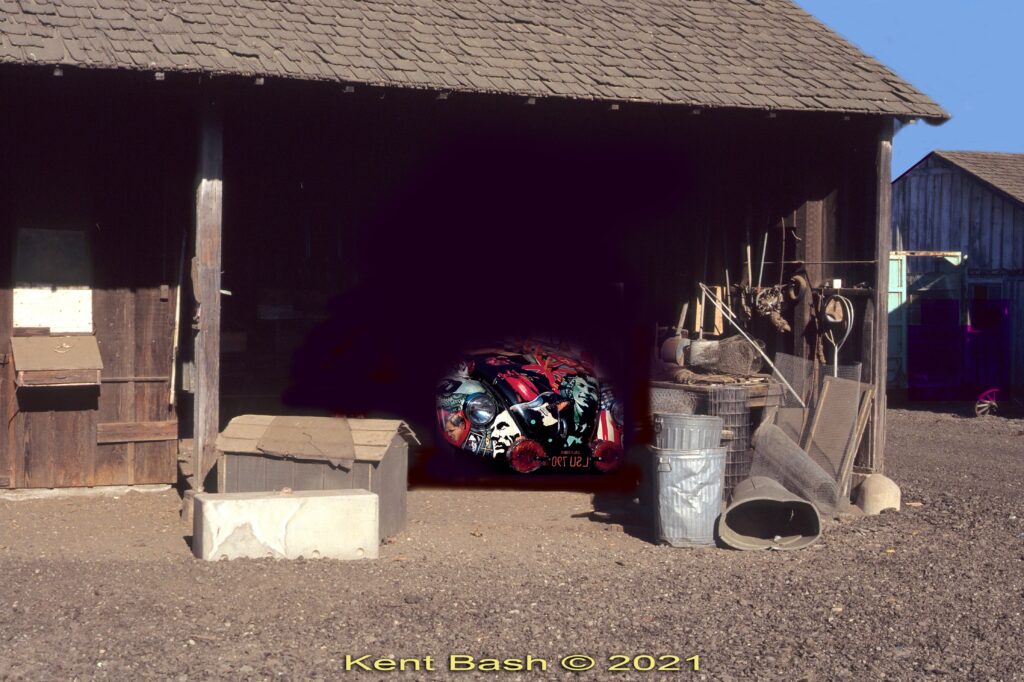
I grabbed up this out building the day I moved in, after removing the junk that sits in front. While there was no a garage for my mobile projects, the canopy worked just fine, out of the rain, and out of the sun. This was actually a Carriage House, where one would keep their horse and carriage. This gives you an idea of just how old these buildings were, but in remarkably good shape. One did get the sense that you had traveled back in time just being here.
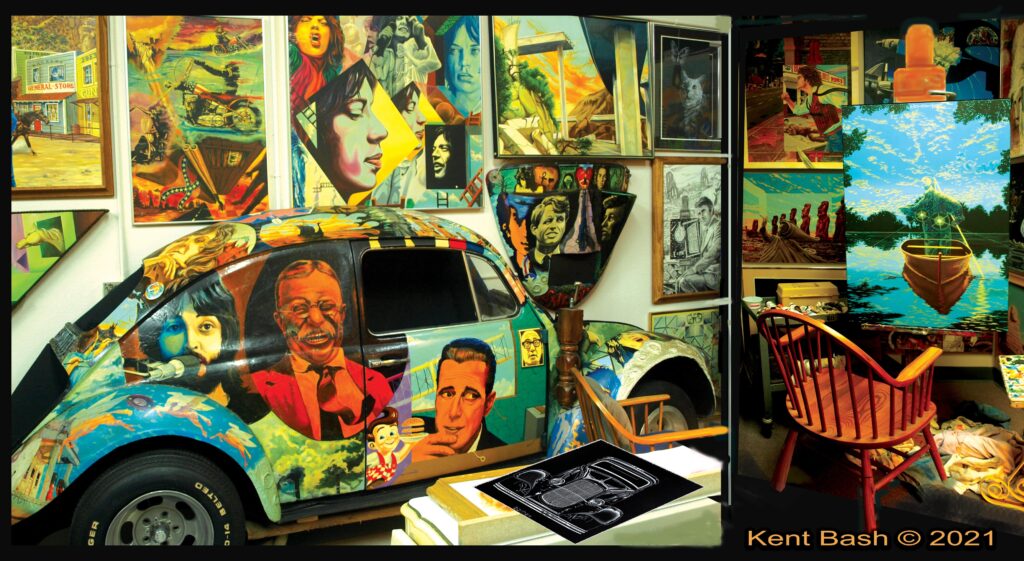
Today, all that is remaining of the precursor to the art cars, the hand painted cars, is some photographs, memories, and this surviving side of the last one destroyed by a traffic accident, interestingly on the boulevard known for the phenomena of Cruising internationally, Van Nuys Boulevard. This was in 1978.
Another surviving part that also hangs next to the surviving side of the wreck in my studio is the rear deck lid of an earlier hand painted bug. The rear deck lid features JFK, and Robert Kennedy. This was painted in 1968 shortly after Robert Kennedy was shot and killed in Los Angeles, California. Lastly, the carcass of the last of the hand painted cars was destroyed by the collector depressingly is on display at the Valley Relics Museum, located Van Nuys, California.
The idea of thinking about having space as a tool was a new one for me, and made perfectly clear by the amount of space I had at the ranch. There was room to create most anything so creating wasn’t limited to painting, and creating art cars. When I needed some chairs, I built some. When I wanted to create someone off models, I did so. When I wanted to try my hand at some carpet graphics, I did that too.
The wonderful thing was, I could leave whatever project I was working on unfinished, with all the tools and mess just sitting where I left them until I came back to work on it, with no one disturbing a thing. Having space also allowed me to hang my work up, so I could see how I was developing. It was also a way to free up floor space from all the stacks and boxes of work, and to better take care of them while they were still in my possession.
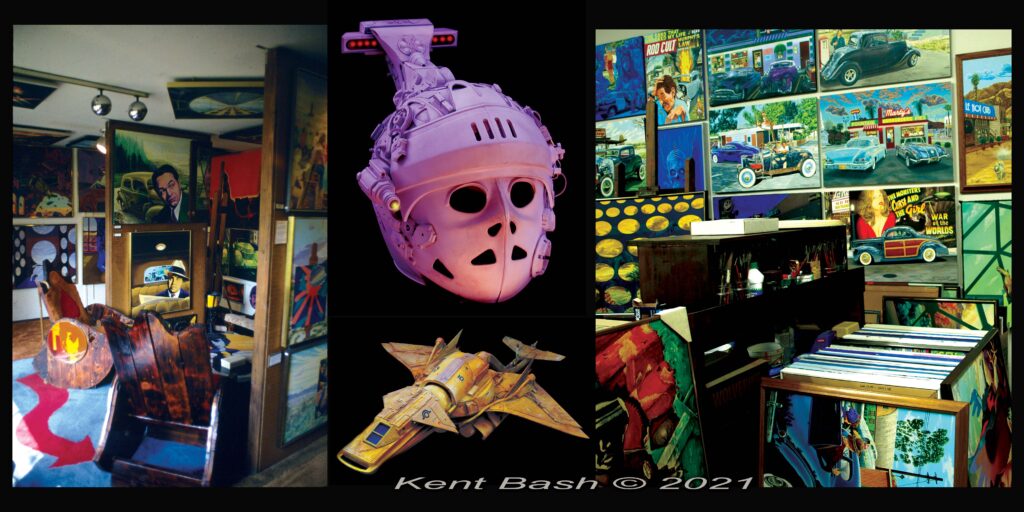
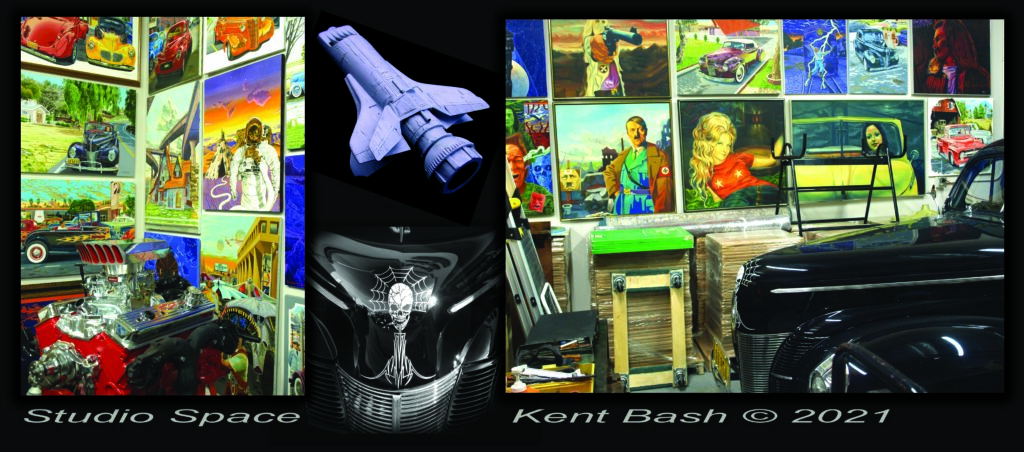
There is a certain irony in having enough space, you use it up, and whatever space you have becomes a clutter of all the things you have been able to do, and you suddenly want more. It’s hard to limit yourself when you are expanding creatively, until you hit gridlock, or the wall. At that point I had to consider becoming more focused, and that’s about all I did, considered it. However, painting and self-expression flourished in the 1970s and 1980s, and some new interests entered the picture.
As much of my work conveys an idea, observation, or seems to carry a narrative, it attracted the attention of Science Fiction author, Harlan Ellison, when he first saw my work at the Cafe Four Oaks, Restaurant on Beverly Glen, in Bel Air, California. Owner, Jack Allen, a former actor, loved my very pointed work and thought an on going exhibit of my work would appeal to his eclectic clientele, composed of many Hollywood actors, assorted entertainers, writers, and film and TV directors. And, he was right. The interesting aspect of this was, that many of these paintings you may not likely have ever seen in an art show, or for sale in a gallery. They were simply too controversial, or abrasive.
Shortly after Science Fiction author, Harlan Ellison purchased some of my work at the Cafe Four Oaks, restaurant I received a call from Harlan, and he wanted to see more. He then asked if knew Terry Martin, who was his personal secretary. I was surprised my old musician, and aspiring poet friend was working for Harlan. My gallery-studio was only a short distance, so they made the trek.
Harlan seemed taken by my eclectic collection of work, and wanted me to illustrate a book, and paint a magazine cover for something he’d been working on. They both would be my first if I accepted. It was something I had imagined doing since childhood, but I was set on my own journey. I decided to do it, except I put a limitation on how much of this I might do.
The cover he wanted was going to be for Fantasy & Science Fiction Magazine. I told him I don’t work under thumb. Give me story, I will read it and come up with something. And, I also don’t do sketches, I’m not a commercial artist, but I do understand art with a narrative. I wanted the art to be as original as my other work, and to capture what I’ve always enjoyed about reading a good story. The imagery my own imagination came up with. I didn’t really expect anyone to actually agree to this, but both Harlan Ellison, and Ed Ferman, then owner of Fantasy & Science Fiction Magazine did, and gave me a shot. In later years the new owner Gordon Van Gelder did as well. I’ve been doing one each year for the past 41 years, and still look forward to doing the next.
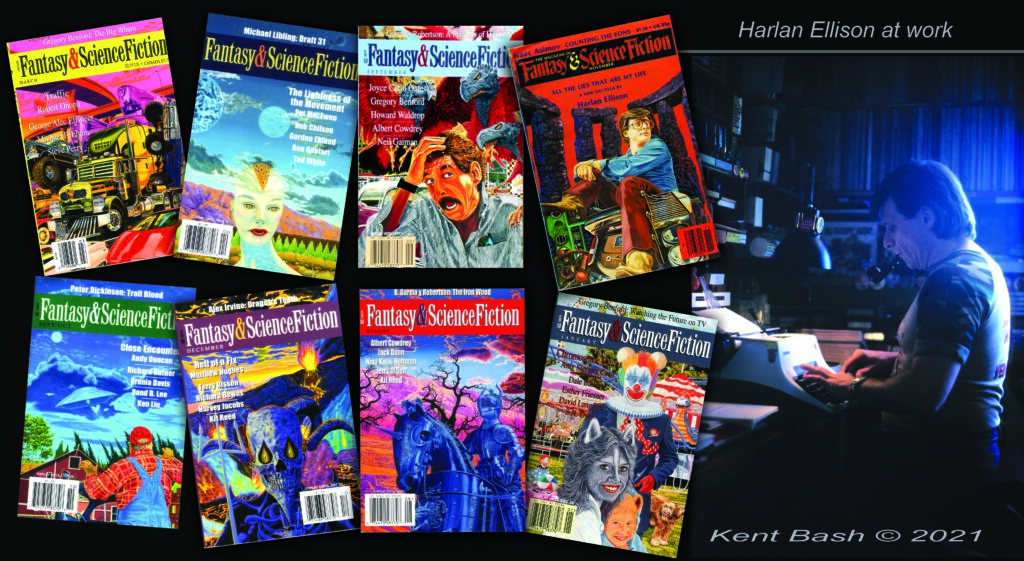
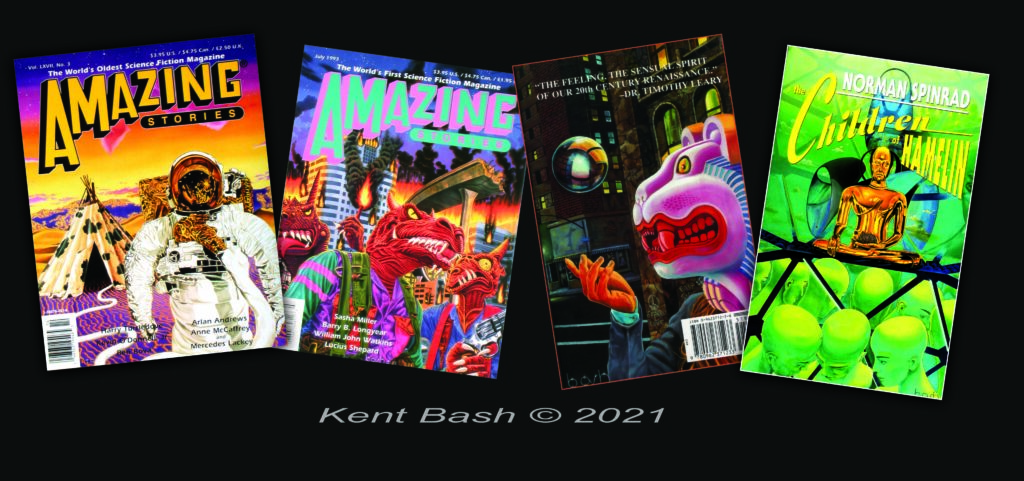
Surprisingly, there were a number of other publishers who also accepted my terms. Still, I kept this no a minimum. Interestingly, I had a number of paintings in my collection that either fit a story, or stood on their own as book, or magazine covers. That was handy sure enough.
At nearly around the same time as I became involved with science fiction books and magazines, I met Gary and Dian Lick, of Midnight Impressions, fellow hot rodders in the silkscreen business. Gary and I hit it off from the day we first met. Gary saw my work and wanted to meet me, and next thing I knew I was in the silkscreen business. The thing was, I had an inventory of art that might be useable as shirt designs. At first we used the charcoal drawings of cars. They seemed to work very well printed on white, or light colors. But what I wanted to see is how my paintings on black printed on black. That would take some work, and to change how that was done to a different approach all together. Here are the results. The problem was car guys didn’t buy black shirts, until we introduced ours. It was a game changer. It was a joy to see these paintings on black finally have a use that they seemed to be designed for. Eventually some of my hot rod paintings came to life as silkscreened designs as well.
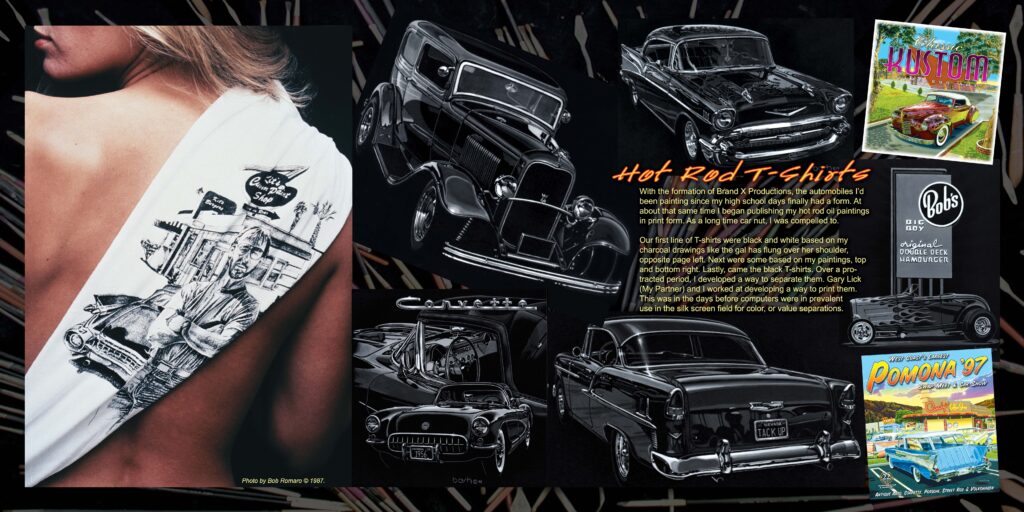
What we were making began to attract attention and collect an audience of car guys. They were not event shirts, but car art shirts. That was different, and was appreciated. We did create some event shirts too, as a consequence of our line, but that was not our primary focus.
The hot rod, classic cars, muscle car, and truck art drew the attention of some of the magazines, like Street Rodder, and Rod & Custom who both did features on my paintings about the time I began publishing them as a line of prints. Landmark Calendars wanted to publish a calendar featuring 12 of them using my graphic slogan, “Lost In The 50s”, which Gary Lick, my partner , and friend came up with when he colorized one of my charcoal drawings to print our first shirt. The drawing featured two 34 Fords pulling out of a Texaco gas station. Interestingly, when Texaco oil executives, at headquarters saw these shirt they just had to have some.
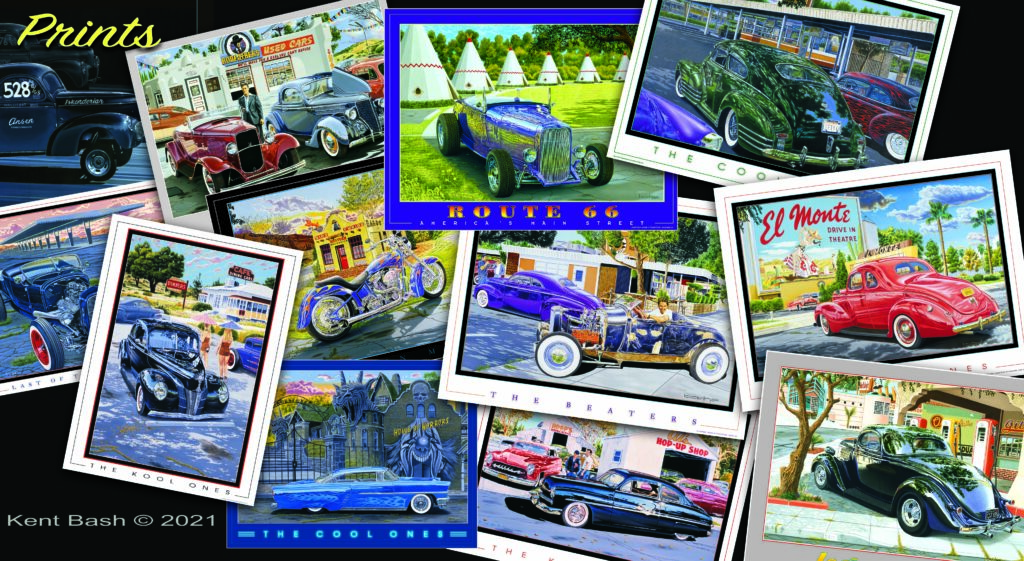
Here are a few of the hot rod paintings I’m speaking of, and that I published in print form. There are more of course. These are the type paintings that rod, custom, and motorcycle magazines and book publishers were most interested in.
When author, Mike Witzel, saw my painting, “Cruise Night at Bob’s”, he contacted me, and asked if he could use it in a book he was \working on, “The American Drive-in”. We had a nice long conversation about our mutual interests in books, and I shared my involvement in science fiction books, and magazines. Then we spoke of the possibility of doing a book together. He suggested doing a book on my hot rod, car culture art, and I suggested we do a book about what the paintings were about. This then became the seed behind our book, “Cruising’ ”, which was published by Motorbooks International in 1997.
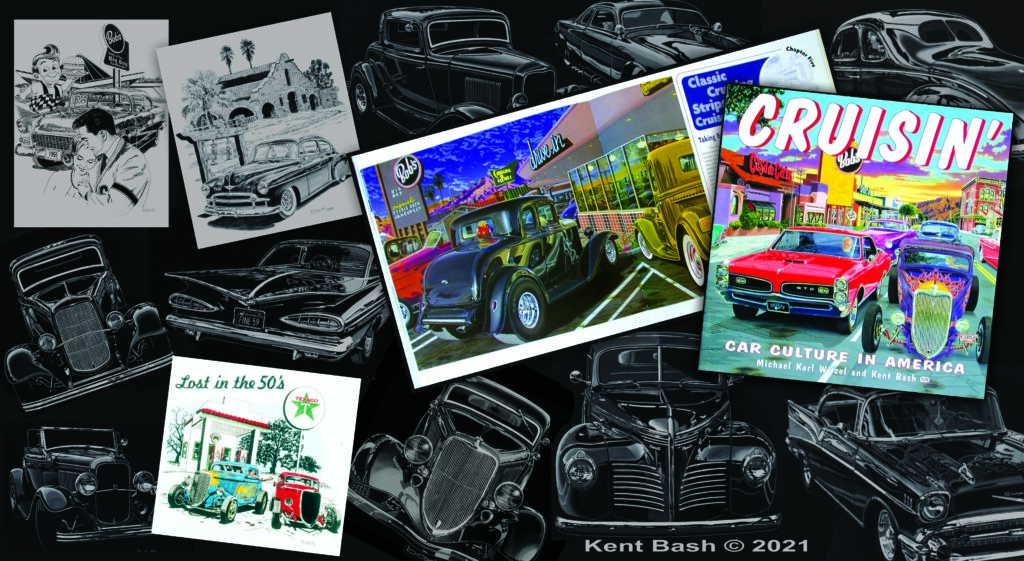
Motorbooks initially didn’t like the manuscript, they thought it was too highbrow for car guys. It was ridiculous of course, and Mike was pissed off.
He’d have to dumb it down. Never-the-less, it was an award-winning book, that was mimicked many times by many publishers, including our own. We wanted our book to reflect more regular folks, car guys, car culture, traditions and rituals, and less on the super stars of hot rodding.
Years ago, a gentleman by the name of Arron Lasky asked me at a car show if I would plug in with them to support Hot Rod Deluxe, a new hot rod magazine idea he had about covering the new movement in hot rodding, trying to recapture the roots of hot rodding when car guys built home made hot rods from junk, or by parts they fabricated. Shortly thereafter he quit, went back to Bakersfield California to form a new magazine, Car Kulture Deluxe. I joined them early on, when Arron had decided to return to college, and finish his education. It was a rough go, no one knew exactly how to do a magazine but were doing it anyway. So everyone learned by doing, including me. I wanted to know how magazines operated from the inside out. Everyone considered it a rag, including us, but we all learned.
I was new to the computer as well, and I had long wanted to write and design my own articles or stories. This was my inspiration for learning both the computer, and how to do what I imagined. I have been unhappy with the way books and magazines are designed. Too many cooks in the kitchen, crappy layout designs, important photos and art too small, and too much regimentation. All this played into my urge to stick with it until I could see it was both possible, and doable.
One of the two partners, was increasingly unhappy, he seemed to be doing all the work while the other claimed the money. Zombie aka Scott Stevens, wanted to start another magazine, so we started to work on it. It didn’t have a name yet, and we played with dozens and dozens, but nothing seemed to feel quite right. I did have a couple of humorous fictional hot rod magazine cover paintings called Rod Cult, and Zombie expanded it to Rod & Kulture, and the new magazine was born.
But, for me, the more important issue was, could I write and design together, playing the text off the photos or art or both, and make the quality of both better. Artists have been making Zines for years, so the idea wasn’t exactly
new, but working this way for a magazine was. This was something magazines don’t allow, but in this situation it was allowed for me for both Car Kulture Deluxe, before it was sold, and after with Rod & Kulture. As an example, here is page 1 & 2 of a five-page article for Rod & Kulture from some years back.

